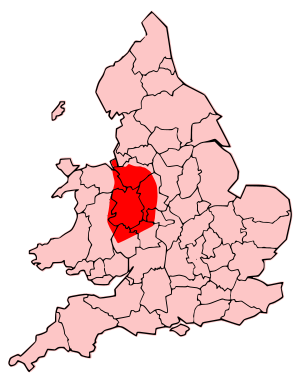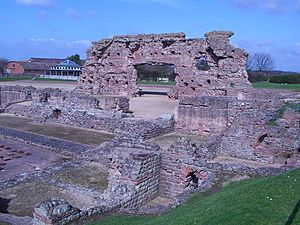Cornovii (Midlands) facts for kids
Quick facts for kids Cornovii |
|
 Territory of the Cornovii |
|
| Geography | |
| Capital | Viroconium (Wroxeter) |
|---|---|
| Location | Shropshire Federation of Stoke-on-Trent Cheshire |
| Rulers | None known |
The Cornovii were an ancient Celtic people who lived in Britain during the Iron Age and Roman Britain times. Their home was mainly in what is now central England, including parts of Cheshire, Shropshire, and Staffordshire. They also lived in eastern parts of Wales, like Flintshire and Wrexham.
Before the Romans arrived, their main town was probably a hillfort on the Wrekin. Later, under Roman rule, their capital became Viroconium Cornoviorum (modern Wroxeter). The Cornovii shared borders with other tribes like the Brigantes to the north and the Corieltauvi to the east.
It's interesting to know that other groups in Britain, far away in northern Scotland and Cornwall, were also called Cornovii. However, experts believe these groups were separate and not related to the Cornovii of central England.
Contents
What Does the Name Cornovii Mean?
The name "Cornovii" might mean "People of the Horn." Some historians think this name could be linked to a "horned god" that the tribe worshipped. While there's no direct proof, it's interesting that a traditional "horn dance" still happens today in Abbot's Bromley, which is not far from the old Cornovii capital at Wroxeter. This dance might be a very old tradition from pagan times.
Clues from Archaeology
Archaeologists study old objects and sites to learn about the Cornovii. They haven't found many unique types of pottery made by the Cornovii themselves. However, recent digs in Poulton, Cheshire, have uncovered a lot of rough pottery. This type of pottery was used for making, storing, and moving salt, which was a very important resource back then.
The Cornovii were skilled builders of hillforts. These were large, fortified settlements on hills, used for protection. Important Cornovii hillforts include Titterstone Clee and Old Oswestry. One of these hillforts might have been the last place where the British leader Caratacus fought against the Romans in 50 AD.
The Story of Vedica
Archaeologists found a tombstone in Ilkley, Yorkshire, for a 30-year-old Cornovian woman named Vedica. This was outside the main Cornovii territory. The stone says: "To the spirits of the departed and to Vedica, thirty years old, daughter of Virico of the Cornovii; she lies here."
Vedica might have been the daughter of a Cornovian chief named Viroco. Her tombstone is the only clue we have about ordinary people living in Ilkley during Roman times.
Life Before the Romans Arrived
Before the Roman invasion in 47 AD, the Cornovii lived in many important hillforts. Besides Titterstone Clee, other key hillforts were Chesterton Walls and Bury Walls in Shropshire. The Wrekin hillfort, near modern Wellington, was also a major settlement. Another significant one was the Breiddin hillfort in Powys, Wales.
Some experts used to think the Cornovii weren't very wealthy or advanced because they didn't find much metal or fancy pottery. They believed the Cornovii mostly raised animals and grew some crops in river valleys. However, new discoveries at Poulton show that the Cornovii did work with metals and made ceramics. They even found a special iron tool buried in a round house ditch, which suggests they had some wealth. It seems that many ordinary people lived in the lowlands, paying tribute (like cattle or grain) to the chiefs in the hillforts.
The Roman Era

The main city for the Cornovii under Roman rule was Viroconium Cornoviorum, or just "Viroconium." It grew to be the fourth-largest town in Roman Britain! It started as a Roman army base in the mid-1st century. A major Roman road, Watling Street, connected Viroconium all the way to Dover. The city's name itself might come from the Wrekin hillfort, which overlooked the site.
The size of Viroconium was much larger than what you'd expect from the number of known pre-Roman settlements. This suggests that many people might have lived in wooden homes that didn't leave much trace for archaeologists. Still, impressive Roman ruins can be seen today near the village of Wroxeter.
As Viroconium grew, it became a true Roman city with all the important buildings. It had a basilica (a large public hall), shops, and public baths. The remains of the baths show that Viroconium was most successful between the 2nd and 3rd centuries. It was a busy economic center for the region. However, by the 4th century, the city began to decline.
Viroconium is special because, unlike many other major Roman towns in Britain, it didn't grow into a big city after the Romans left. This might be because the nearby town of Shrewsbury was founded later (around the 9th century) and was easier to defend. Because the Wroxeter area hasn't been built over much, many Roman remains are still well-preserved, making it a favorite spot for archaeologists.
The Cornovii in the Roman Army
The Cohors Primae Cornoviorum was a unique Roman army unit. It was the only known unit made up of native British people who served in Britain. This infantry unit, likely with about 500 soldiers, was recruited directly from the Cornovii tribe. In the late 4th century, this unit was stationed at Pons Aelius (Newcastle upon Tyne), guarding the eastern end of Hadrian's Wall.
Other Roman Settlements and Forts
The Cornovii territory had many smaller Roman settlements and military forts. These places helped the Romans control the area and move goods. Some important ones included:
- Bovium (near Tilston, Cheshire): A minor settlement.
- Wilderspool (near Warrington, Cheshire): Another small settlement.
- Bravonium (Leintwardine, Herefordshire): A small roadside town and important military complex on Watling Street.
- Uxacona (Red Hill, near Oakengates, Shropshire): A small settlement east of Wroxeter.
- Pennocrucium (Water Eaton): A small town and military complex.
- Letocetum (Wall, near Lichfield, South Staffordshire): A small town with public baths, important for local administration.
- Rutunium (Harcourt Park, Shropshire): A small settlement and stopping point on the road between Wroxeter and Chester.
- Mediolanum (Whitchurch) (Shropshire): A Romano-British settlement that might have been a small walled town.
- Salinae (Middlewich, Cheshire) and Condate (Northwich, Cheshire): These towns were important for salt production.
- Rocester (North Staffordshire): A small town and fort on the border with other tribes.
After the Romans Left
After the Roman army left Britain, life in the Cornovii lands changed. Viroconium, once a major city, saw many of its buildings fall apart. However, between 530 and 570 AD, there was a big effort to rebuild the city using timber. Many old Roman structures were taken down, and new wooden buildings, including a large two-story building, storage areas, and houses, were put up.
Archaeologists say these new buildings were carefully planned and built by skilled workers using Roman measurements. We don't know who led this rebuilding, but it might have been a bishop. This new community lasted about 75 years before the buildings were taken apart for some unknown reason.
The Dark Ages
After this period, the power of the Angles (who would later form England) grew in the Midlands. The Cornovii's land eventually came under the rule of the Kingdom of Pengwern. Pengwern later joined with the powerful kingdom of Mercia after 642 AD. The local Cornovian people likely continued to live in the area, perhaps as a group known as the Wreocensæte, under Mercian rule.
The Roman city of Viroconium was known in Old Welsh as Caer Guricon. It might have been the capital of the Kingdom of Powys for a while during this time. But as the Anglo-Saxons pushed further west, the British people of Powys had to move their capital to Mathrafal castle before 717 AD. The kingdoms of Pengwern and Powys might have been later divisions of the original Cornovii territory.
Images for kids
See also
- List of ancient Celtic peoples and tribes
- Dumnonii
- Powys
- Forest of Lyme


